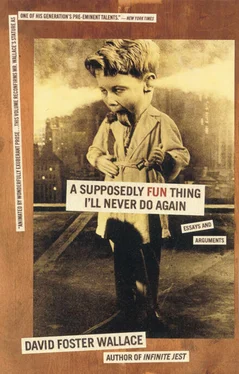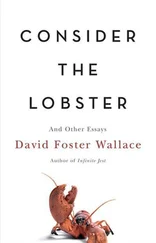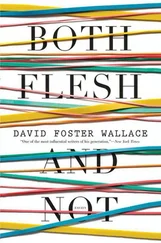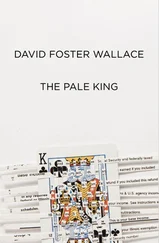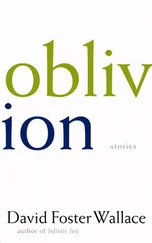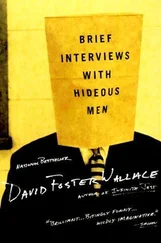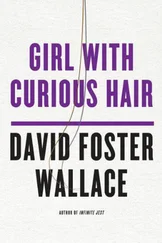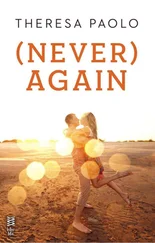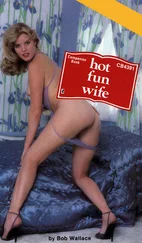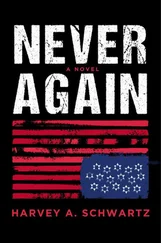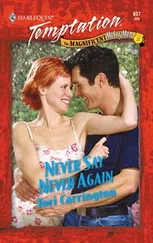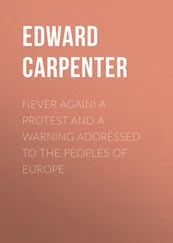I don’t mean to make it sound like this kind of thing is wholly good or that Lynch is some kind of paragon of integrity. His passionate inwardness is refreshingly childlike, but I notice that very few of us choose to make small children our friends. And as for Lynch’s serene detachment from people’s response, I’ve noticed that, while I can’t help but respect and sort of envy the moral nerve of people who truly do not care what others think of them, people like this also make me nervous, and I tend to do my admiring from a safe distance. On (again) the other hand, though, we need to acknowledge that in this age of Hollywood “message” films and focus-group screenings and pernicious Nielsenism — Cinema By Referendum, where we vote with our entertainment-dollar either for spectacular effects to make us feel something or for lalations of moral clichés that let us remain comfortable in our numbness — Lynch’s rather sociopathic lack of interest in our approval seems refreshing/redemptive (if also creepy).
17 the only part of this article that’s really in any way “behind the scenes”
Asymmetrical Productions’ headquarters is, as mentioned, the house next door to Lynch’s house. It really is a house. In the yard outside the door are a department store swingset and a Big Wheel on its side. I don’t think anybody really lives there; I think it gets treated as an annex to Lynch’s own house and that Lynch’s children’s play spills over. You enter A.P.HQ through a sliding glass door into what is the house’s kitchen, with a Mannington tile floor and a dishwasher and a fridge with witty magnets on it, plus there’s a kitchen table where a college-age kid is sitting working diligently at a laptop, and at first it all looks like some ur-domestic scene of a college kid home at his folks’ house for the weekend or something, except when you come closer you start to notice that the kid’s got a scary haircut and a serious facial tic, and what he’s doing on the laptop is cueing a still-frame shot of the brunette Patricia Arquette’s mutilated corpse against some set of coded specs on a clipboard that’s propped against his Boynton mug of coffee. It’s unclear who the kid is or just what he’s doing or whether he even gets paid to do it. 40
As in much of the Hollywood Hills, Asymmetrical’s street is more like a canyon, and people’s yards are 80° slopes with ice-plant lawns, and the HQ’s entry/kitchen is actually on the house’s top level, so that if you want access to the rest of the house you have to go down a vertiginous spiral staircase. This and various other stuff satisfies reasonable expectations of Lynchianism w/r/t the director’s working environment. The HQ’s bathroom’s Cold knob doesn’t work and the toilet seat won’t stay up, but on the wall next to the toilet is an incredibly advanced and expensive Panasonic XDP phone with what looks like a fax device attached. Asymmetricale receptionist, Jennifer, a statutorily young female who’d be gorgeous if she didn’t have Nosferatic eyeshadow and cadet-blue nail polish on, blinks so slowly you have to think she’s putting you on, and she declines to say for the record what music she’s listening to on her headphones, and on her desk next to the computer and phones is one copy of Deleuze and Guittarri’s Anti-Oedipus and one copy each of Us and Wrestling World . Lynch’s own office — way below ground, so that its windows must look out on solid earth — has a big solid gray door that’s closed and looks not only locked but somehow armed , such that only a fool would try the knob, but attached to the wall right outside the office door are two steel boxes labeled OUT and IN. The OUT box is empty, and the IN contains, in descending order: a 5,000-count box of Swingline-brand staples; a large promotional envelope, with Dick Clark’s and Ed McMahon’s pointillist faces on it, from the Publisher’s Clearinghouse Sweepstakes, addressed directly to Lynch at Asymmetrical’s address; and a fresh shrink-wrapped copy of Jack Nicklaus’s instructional video Golf My Way . Your guess here is as good as mine.
Premieres industry juice (plus the niceness of Mary Sweeney) means that I am allowed to view a lot of Lost Highway ’s rough-cut footage in the actual Asymmetrical Productions editing room, where the movie itself is going to be edited. The editing room is off the kitchen and living room on the house’s top level, and it clearly used to be either the master bedroom or a really ambitious study. It has gray steel shelves filled with complexly coded canisters of Lost Highway ’s exposed film. One wall is covered with rows of index cards listing each scene of Lost Highway and detailing technical stuff about it. There are also two separate KEM-brand flatbed viewing and editing machines, each with its own monitor and twin reel-to-reel devices for cueing up both film and sound. I am actually allowed to pull up a padded desk chair and sit there right in front of one of the KEMs’s monitor while an assistant editor loads various bits of footage. The chair is old and much-used, its padded seat beaten over what has clearly been thousands of hours into the form-fitting mold of a bottom, a bottom quite a lot larger than mine — the bottom, in fact, of a combination workaholic and inveterate milkshake-drinker — and for an epiphanic moment I’m convinced I’m sitting in Mr. David Lynch’s own personal film-editing chair.
The editing room is dark, understandably, its windows first blacked out and then covered with large Abstract Expressionist paintings. These paintings, in which the color black predominates, are by David Lynch, and with all due respect are not very interesting, somehow both derivative-seeming and amateurish, like stuff you could imagine Francis Bacon doing in jr. high. 41
Far more interesting are some paintings by David Lynch’s ex-wife that are stacked canted against the wall of Mary Sweeney’s office downstairs. It’s unclear whether Lynch owns them or has borrowed them from his ex-wife or what, but in Lost Highways first act, three of these paintings are on the wall above the couch where Bill Pullman and Patricia Arquette sit watching creepy invasive videos of themselves asleep. This is just one of David Lynch’s little personal flourishes in the movie. The most interesting of the paintings, done in bright primaries with a blunt blocky style that’s oddly affecting, is of a lady in a tank-top sitting at a table reading a note from her child. Superimposed above this scene in the painting is the text of the note, on what is rendered as wide-rule notebook paper and in a small child’s hand, w/ reversed e’s and so on:
Dear Mom I keep having my fish dream. They bite my face! Tell dad I dont take naps. The fishes are skinny an mad I miss you. His wife makes me eat trouts and anchovys The fishes make nosis they blow bubbels. How are you [unreadable] you fine? don’t forget to lock the doors the fishes [unreadable] me they hate me.
Love form
DANA
In the painting, what’s moving is that the text of the note is superimposed such that parts of the mother’s head obscure the words — those are the “[unreadable]” parts. I do not know whether Lynch has a child named Dana, but considering who the artist is, plus the painting’s child’s evident situation and pain, it seems both deeply moving and sort of sick that Lynch would display this piece on a wall in his movie. Anyway, now you know the text of one of Bill Pullman’s objets , and you can get the same kind of chill I got if you squint hard enough in the movie’s early interior scenes to make the picture out. And you’ll be even more chilled in a later interior scene in Bill Pullman and Patricia Arquette’s house, a post-murder scene, in which the same three paintings hang above the sofa but are now, without any discernible reason or explanation, upside down. The whole thing’s not just creepy but personally creepy.
Читать дальше
